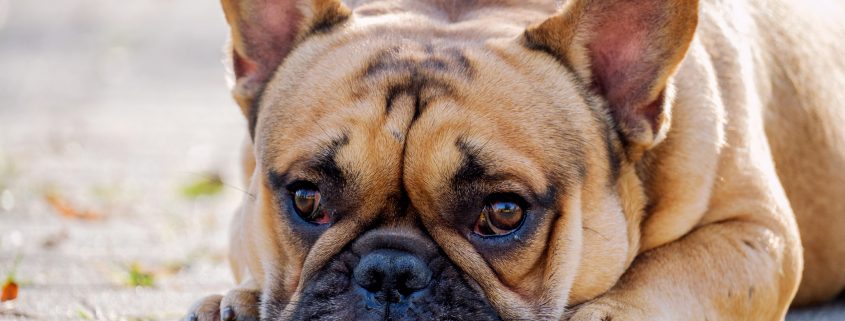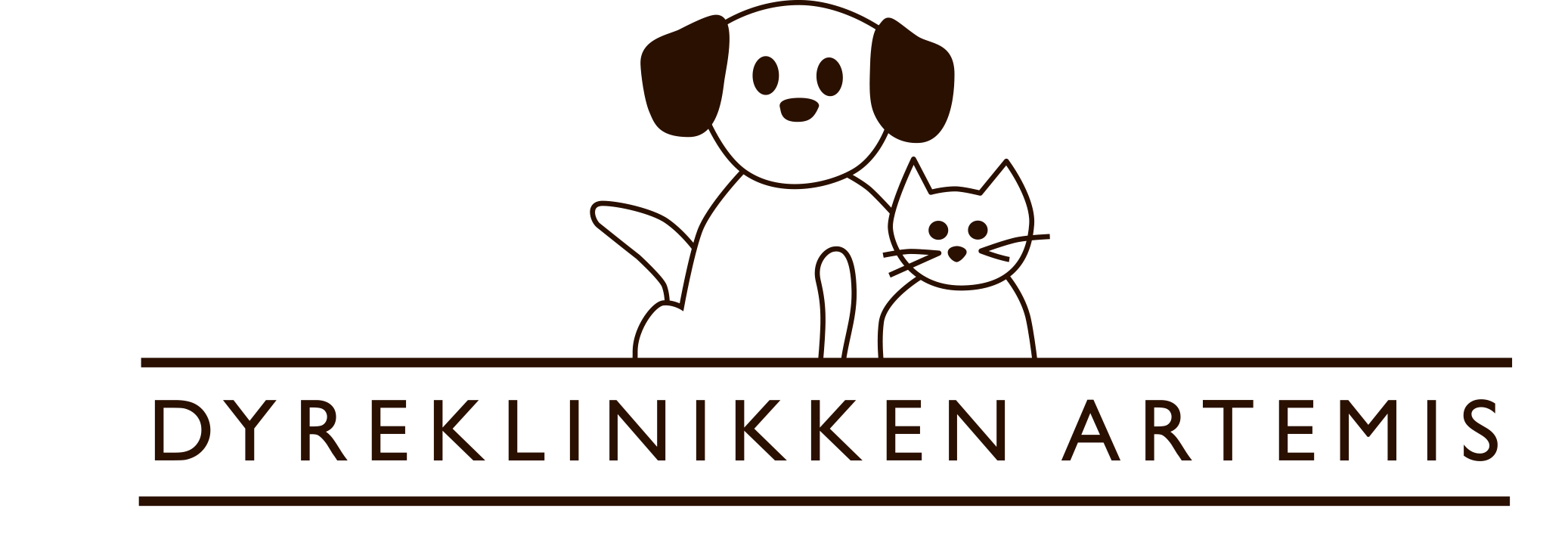
How do I know my dog has bad teeth?
Many older dogs have bad teeth. Tooth problems can appear in many ways, and dogs can be bothered by it at many different levels.
Typically, a first sign would be a problem in the oral cavity, where the dog smells badly. Some drools more than normal, will not chew hard things or eat its food, but only softer food. A characteristic is that some dogs with bad teeth lick and smack their lips, are quieter and even sometimes the dog will growl if we pet its head.
In case the dog was not used to having its mouth checked since it was a puppy, then it can get difficulty for the owner to have a look at the teeth, if we suspect an oral problem.
When the vet examines the teeth of the dog, then he pulls up the lips to expose the teeth. The vet will look for tartar. If the gums are red and irritated, then it might already be the start of a periodontal disease.
It can be hard to find out if rotten teeth are hiding behind the tartar. Maybe the gums have “drawn back” and some of the root is showing.
In some cases, “pockets” are created between tooth and gum. That we can feel with a special instrument. It can only be examined while the dog is in anesthesia. An adequate examination can take place when the dog is anaesthetized during the dental cleaning.
How does tooth problems develop?
The teeth of the dog are covered with plaque just like it happens for humans. Plaque is a sort of a thin film covering the teeth. Plaque, which is not removed, will over time get firm and create tartar. You can see if the dog has plaque, when the teeth turn brownish yellow, and when you can’t brush it off, then it has turned into tartar.If the tartar stays too long, then the gums can become inflamed(gingivitis).
If we remove the plaque and tarter, then the inflammation can reverse.
If we let it develop, then it will spread to the pockets of the gums. In the pockets there is no oxygen. The lack of oxygen can lead to “aggressive” bacteria can develop and lead to inflammation in the roots, which is called periodontal disease. If first the dog gets periodontal disease, then it’s not enough just to remove the plaque and tartar since the roots will be infected.
What is a dental cleaning?
It hurts to have the teeth cleaned, therefor the dog goes into full anesthesia. Most dogs won’t let the vet scratch their teeth completely clean, which is never possible without the anesthesia. It would even be cruel for the dog to try and clean up the mouth with severe inflammation.
First, we remove the tartar with an ultrasound-tooth cleaner.
Then all teeth are evaluated with an instrument, which will expose the creation of pockets. Then a complete clean out of the pockets will be done. Maybe there is a need to extract some teeth. Then treatment with antibiotics, and when the inflammation is gone, then the vet will teach the dog owner how to keep the oral cavity as healthy as possible.
Often, we x-ray the teeth. We can’t always tell if a tooth needs to be extracted or need further treatment. An x-ray of the tooth, the root and surrounding structures is an important tool to the right treatment.
Artemis has equipment to x-ray the teeth of dogs and cats.
The dental cleaning is finished off with a polishing of the teeth.
The patient will then wake up peacefully. If there has been an extraction, then it will be followed up with pain relieving medicine.
What is the price?
The price of dental cleaning is often a complicated question, since it depends on which shape the oral cavity is in. As mentioned before, we don’t know the extent completely before the dog is in anesthesia and the teeth are being examined. At Artemis a dental cleaning includes a full anesthesia, dental cleaning being followed by a polishing of the teeth. If we find the need for extraction, and it’s not in agreement with the owner in advance, then we aim at calling the owner during the procedure in case it will increase the price significantly. If we decide to do dental x-ray the price will also increase.
Usually older dogs have very bad teeth. Which is why we often recommend doing a blood profile to see if the dog can handle anesthetics. Here we check the values of the most important organs, so we can adjust the anesthesia to meet the special challenges.
How do I prevent dental problems?
A dental cleaning is the perfect time to start the daily care, so we in the future can prevent dental problems and loss of teeth.
Brushing the teeth
Plaque on the teeth is developed within 24 hours. Which is why daily brushing of the teeth being the best way to prevent dental problems.
If you never have brushed the teeth on your dog before, then you need to get it used to it little by little during some weeks. A small step at a time and rewarded with a treat.
- Start pulling the lips of the dog up.
- “Rub” the outside of the gums/teeth with a finger or a finger-toothbrush.
- The most important teeth would be the canines and the two larger molars in the upper part of the mouth, ONLY on the outside.
- Introduce a soft toothbrush
- Then add the toothpaste which has to be a canine toothpaste.
Canine toothpaste must be produced, so it can be swallowed, since the dog doesn’t “gurgle and spit out”. The canine toothpaste doesn’t contain fluoride, partly because dogs don’t get cavies, and as well can’t handle fluoride in the stomach. It must taste well, so the dog will allow it in its mouth. Save the toothpaste for last, since some dogs wanna chew the toothbrush if the toothpaste is introduced too early.
The vet has some special soft canine toothbrushes. They are good for a start if the dog is not used to getting its teeth brushed. You can also get a “tooth sock” a finger toothbrush consisting of microfiber, which will absorb the plaque. If you find it hard to use the toothbrush, then the “sock” is a good alternative.
If you get the dog used to an electric toothbrush from when it’s a puppy, then that will be a great way to brush its teeth.
If you at first start just with the two canines and in the upper part of the mouth and the molars, then you are on the way. These are the most important to clean. Plaque usually build up on the outer surface, so if you only can brush these, then you still make a difference.
Vet-aquadent
Vet-aquadent is a great supplement to toothbrushing. It is a green liquid added xylitol and chlorhexidine. Add some liquid to the dog’s drinking water daily. Each time it drinks, it will clean the mouth and help to prevent the plaque on the teeth. The liquid will as well give the dog a fresh breath.
Chewing bones and chew toys
It’s an excellent idea to give the dog some special bones from time to time. If the dog lays down chewing on something, then it helps to remove the plaque. The longer the dog chews, the more it helps on the teeth.
You can buy special dry dog food focused on dental problems (Prescription Diet T/D and Royal Canin (Dental dry dog food). The food contains polyphosphate, which reduces the accumulation of plaque. The food bites are often large, so the dog will have to chew its food before it swallows it, and then the teeth are cleaned.
Who gets the bad teeth?
Some dogs wag their tail through life with beautiful teeth while the owner does nothing for it. Still, it is just a few. Far the most dogs will at one point in life need a dental cleaning. Often it will make the owners to start thinking about a preventive treatment. The best is always to get the dog used to having its teeth brushed from it is a puppy – but it’s NEVER TOO LATE to get the dog started with brushing the teeth.
Don’t start brushing the teeth for real on a puppy, that hasn’t had its adult teeth. It can hurt, when the teeth change.
If you do that, it can lead to, that you will never get inside the mouth. Instead you can slowly during the change of teeth start to put a finger in the dog’s mouth. It will then get used to the coming dental care.
Some dogs are genetically prone to bad teeth, so if the dog at an early age builds up a lot of tartar, then the preventing treatment is so more important. Especially smaller breeds are prone to tartar. Keep an eye on the primary teeth, that they fall out as planned. On many occasions we see double canines in these dogs.
An eating dog doesn’t have bad teeth?
Many will get surprised over the how extensive the dental problem can be. The dog is still eating its food and wags its tail, so it can’t be in pain? The dog must eat to survive. The dog will chew the food in the side of the mouth where it hurts the least or just swallow the food. You can’t count on the eating dog not having a toothache.
To do list!
Get your dog used to have its mouth checked.
Get it used to gently have its gums rubbed, start with a finger. When it is used to that, then you can start using a soft toothbrush and later add canine toothpaste (likely after the change of teeth).
Have a talk with your vet or veterinarian nurse about how to prevent dental problems. Our job is done thoroughly, and we take anesthesia of the dog seriously. It is important that the anesthetic is so sufficient that the dog won’t feel anything. In case a tooth must get extracted, then a “light” anesthetic won’t be enough to relieve the pain of the dog.
Dental problems such as periodontal disease can lead to that bacteria from the oral cavity reaches the heart and gives inflammation of the cardiac valves. Because of that, a larger surgical procedure can’t take place at the same time as a dental cleaning.
In theory, daily dental care can help your dog to a longer life. A healthy mouth gives a dog without toothache and a happier dog ?!
In case you suspect your dog has bad teeth?
Send us an email and book an appointment at:
E-mail: info@artemis.dk
